Concert
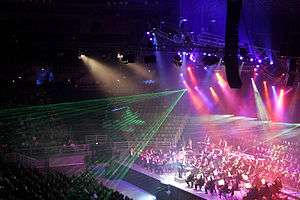
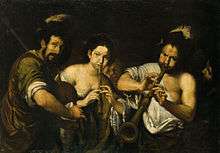
.jpg)
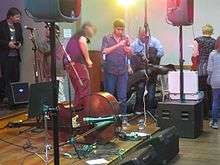
A concert is a live music performance in front of an audience. A recital is a concert by a soloist or small group which follows a program, such as featuring the works of a single composer (organ recital). A recitalist is a musician who gives frequent recitals. The invention of the solo piano recital has been attributed to Franz Liszt.[1]
The performance may be by a single musician, sometimes then called a recital, or by a musical ensemble, such as an orchestra, choir, or band. Concerts are held in a wide variety and size of settings, from private houses and small nightclubs, dedicated concert halls, entertainment centres and parks to large multipurpose buildings, and even sports stadiums. Indoor concerts held in the largest venues are sometimes called arena concerts or amphitheatre concerts. Informal names for a concert include show and gig.
Regardless of venue, musicians usually perform on a stage. Concerts often require live event support with professional audio equipment. Before recorded music, concerts provided the main opportunity to hear musicians play.
.jpg)
Types
The nature of a concert varies by musical genre, individual performers, and the venue. Concerts by a small jazz combo or small bluegrass band may have the same order of program, mood, and volume—but vary in music and dress. In a similar way, a particular musician, band, or genre of music might attract concert attendees with similar dress, hairstyle, and behavior. For example, concert goers in the 1960s often had long hair (sometimes in dread lock form), sandals and inexpensive clothing made of natural fibers. Regular attendees to a concert venue might also have a recognizable style that comprises that venue's scene. Other Types of concerts, To plan or arrange by mutual agreement. To adjust; settle.
Theatrical
Some performers or groups put on very elaborate and expensive shows. To create a memorable and exciting atmosphere and increase the spectacle, performers frequently include additional entertainment devices. These can include elaborate stage lighting, electronic imagery via (IMAG) system and/or pre-recorded video, inflatable sets, artwork or other set pieces, various special effects such as theatrical smoke and fog and pyrotechnics, and unusual costumes or wardrobe. Some singers, especially popular music, augment concert sound with pre-recorded accompaniment, back-up dancers, and even broadcast vocal tracks of the singer's own voice. Activities during these concerts can include dancing, sing-alongs, and moshing. Performers known for including these elements in their performances include: Pink Floyd, The Flaming Lips, Cher, Alice Cooper, Iron Maiden, Daft Punk, Lady Gaga, Jean Michel Jarre, Sarah Brightman, KISS, Gwar, Slipknot (band), and Madonna.
Festivals
Concerts involving a greater number of artists, especially those that last for multiple days, are known as festivals. Unlike other concerts, which typically remain in a single genre of music or work of a particular artist, festivals often cover a broad scope of music and arts. Due to their size, festivals are almost exclusively held outdoors. New platforms for festivals are becoming increasingly popular such as Jam Cruise, which is a festival held on a cruise ship, as well as Mayan Holidaze, which is a destination festival held in Tulum. A few examples of the hundreds of festivals around the world include:
- Big Day Out, Australia
- Coachella Valley Music and Arts Festival, United States
- Download Festival, United Kingdom
- V Festival, United Kingdom
- Falls Festival, Australia
- Frutillar Musical Weeks, Chile
- Electric Daisy Carnival, United States
- Glastonbury Festival, United Kingdom
- Lollapalooza, United States
- Reading and Leeds Festivals, United Kingdom
- Rock Werchter, Belgium
- Pukkelpop, Belgium
- Roskilde Festival, Denmark
- Newport Jazz Festival, United States
- Oxegen Festival, Ireland
- Ozzfest, United States
- Parachute Music Festival, New Zealand
- Rock In Rio, Brazil
- TIM Festival, Brazil
- Rockwave Festival, Greece
- Salzburg Festival, Austria
- Musique et Histoire (France)
- Summer Sonic Festival, Japan
- Tomorrowland, Belgium
- Viña del Mar International Song Festival, Chile
- Woodstock Music and Art Festival, United States
- Soundwave Festival, Australia
- Warped Tour, United States
- Nice Jazz Festival (France)
- Paradiso, United States
Concert tour
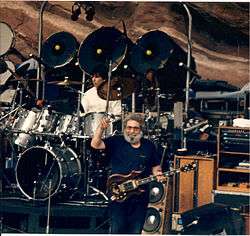
A concert tour is a series of concerts by an artist or group of artists in different cities or locations. Often concert tours are named, to differentiate different tours by the same artist and associate a specific tour with a particular album or product (for example: Iron Maiden World Slavery Tour). Especially in the popular music world, such tours can become large-scale enterprises that last for several months or even years, are seen by hundreds of thousands or millions of people, and bring in millions of dollars (or the equivalent) in ticket revenues.
Different segments of longer concert tours are known as "legs".[2] The different legs of a tour are denoted in different ways, dependent on the artist and type of tour, but the most common means of separating legs are dates (especially if there is a long break at some point), countries and/or continents, or different opening acts. In the largest concert tours it is becoming more common for different legs to employ separate touring production crews and equipment, local to each geographical region. Concert tours are often administered on the local level by concert promoters or by performing arts presenters. Usually, small concert tours are managed by a road manager whereas large concert tours are managed by a tour manager.
Revenue
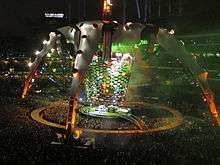
While admission to some concerts is free, it is common practice to charge money for concerts by selling admission tickets. Historically, concerts were the primary source of revenue for musicians. Revenue from ticket sales typically goes to the performing artists, producers, venue, organizers and the brokers. In the case of benefit concerts, a portion of profits often go towards a charitable organization.
Additional revenue is also often raised through in-concert advertising, from free local concerts for local sponsorships to sponsorships from corporations during major tours e.g. 2009's "Vans' Warped Tour Presented by AT&T". Both Vans and AT&T would have paid significant amounts to have their company names included at the forefront in all marketing material for the Warped Tour.
Concessions and merchandise are also often sold during and after concerts; often by the venue in the case of the former, and by the performing band or artist in the case of the latter.[3]
As of 2011, the highest-grossing concert tour of all time is U2 360 Tour, with gross revenues of $736,137,344.[4] The second highest-grossing concert tour of all time is The Rolling Stones' A Bigger Bang Tour, which earned approximately $558 million between 2005 and 2007.[5] Madonna's Sticky & Sweet Tour, which earned $408 million in 2008 and 2009 was the highest-earning tour by a female artist.[6] It is unlikely that new acts will top these numbers.[7]
See also
References
- ↑ "How Franz Liszt Became The World's First Rock Star". October 22, 2011. Retrieved 17 January 2014.
- ↑ "What is a Concert Tour?". TourBeat. Retrieved 10 January 2015.
A concert tour is an opportunity for musicians to perform over longer periods of time across several cities, which are differentiated by segments known as "legs." Legs of tours of can be denoted by a series of dates that have no long break between them, by geographical regions or destinations, or by different opening acts. Each city or region may have the same opening act for each leg, or they may change opening acts at each city.
- ↑ Waddell, Ray (March 7, 2009). "Ticketonomics" (PDF). Billboard.
- ↑ Waddell, Ray (29 July 2011). "U2 Set to Wrap Biggest Concert Tour Ever". Billboard.com. Retrieved 31 July 2011.
- ↑ Pietrolungo, Silvio (April 9, 2007). "Rolling Stones Tour Grosses More Than Half A Billion". Billboard. Retrieved 2009-11-17.
- ↑ "Madonna Closes Tour In Tel Aviv;Second Highest Grossing Trek Of All Time". Billboard. September 2, 2009. Retrieved 2014-01-08.
- ↑ Johan, Jillian. "The Show Must Go On". aei. Retrieved 10 January 2015.
External links
| Wikimedia Commons has media related to Concerts. |
| Wikiquote has quotations related to: Concert |
- Hartman, Mitchell (August 31, 2015). "I've Always Wondered: 'The Travellin' Band'". Marketplace. Retrieved September 1, 2015. A piece on the economics of touring.